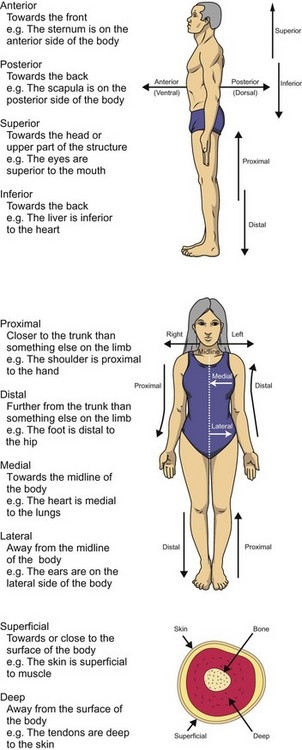Chapter Two Functional musculoskeletal anatomy
Introduction
 providing a basic understanding of how the musculoskeletal structures of the body function, especially in the production of movement
providing a basic understanding of how the musculoskeletal structures of the body function, especially in the production of movement
 allowing sports trainers to more accurately describe the location of an injury, especially for the purposes of referral
allowing sports trainers to more accurately describe the location of an injury, especially for the purposes of referral
 enhancing the ability of sports trainers to recognise when an injury has caused a change to the normal appearance or function of a region of the body.
enhancing the ability of sports trainers to recognise when an injury has caused a change to the normal appearance or function of a region of the body.
Anatomical terminology
All terminology relates to this anatomical position. The terms regarding the location and relationship of body parts are shown in Table 2.1 and Figure 2.1.
Table 2.1 Anatomical terms denoting relationship and comparison
| Term | Description |
|---|---|
| TERMS OF RELATIONSHIP | |
| Anterior | Nearer to the front of the body (e.g. the sternum is on the anterior side of the body) |
| Posterior | Nearer to the back of the body (e.g. the scapula is on the posterior side of the body) |
| Superior | Nearer to the top of the head (e.g. the eyes are superior to the mouth) |
| Inferior | Nearer to the soles of the feet (e.g. the liver is inferior to the heart) |
| Medial | Nearer to the midline of the body (e.g. the heart is medial to the lungs) |
| Lateral | Away from the midline of the body (e.g. the ears are on the lateral side of the head) |
| TERMS OF COMPARISON | |
| Proximal | Nearer to the trunk (e.g. the shoulder is proximal to the hand) |
| Distal | Further from the trunk (e.g. the foot is distal to the hip) |
| Superficial | Near to the surface or on the surface (e.g. skin is superficial to muscle) |
| Deep | Further from the surface (e.g. the tendons are deep to the skin) |
| Ipsilateral | On the same side of the body (e.g. the gallbladder is ipsilateral to the liver) |
| Contralateral | On the opposite side of the body (e.g. the spleen is contralateral to the liver) |
Description of anatomical movements
The terms regarding movement are set out in Table 2.2 and Figure 2.2.
Table 2.2 Terms describing movement
| Term | Description |
|---|---|
| Flexion | Movement at a joint resulting in a decrease in the angle between the two bones |
| Extension | Movement at a joint resulting in an increase in the angle between the two bones |
| Abduction | Movement away from the midline of the body |
| Adduction | Movement towards the midline of the body |
| Inversion | Movement of the sole of the foot inwards |
| Eversion | Movement of the sole of the foot outwards |
| Plantar flexion | Pointing the foot |
| Dorsiflexion | Lifting the foot towards the shin |
| Rotation | Rotation of a bone around its own axis |
| Internal rotation | Rotation of the bone towards the midline of the body |
| External rotation | Rotation of the bone away from the midline of the body |
| Circumduction | The distal end of the bone follows a circular path and the proximal end stays stable. Circumduction is a combination of flexion, abduction, extension and adduction |
| Supination | Outward rotation of the forearm (palm faces anterior) |
| Pronation | Inward rotation of the forearm (palm faces posterior) |
| Elevation | Raising the shoulder towards the head |
| Depression | Lowering of the shoulder towards the feet |
The skeletal system
On average, the skeleton of an adult consists of 206 bones. It has five functions:
1. providing the basic shape and support of the body
3. producing movement in conjunction with the muscles
4. storing minerals, in particular calcium and phosphorus











